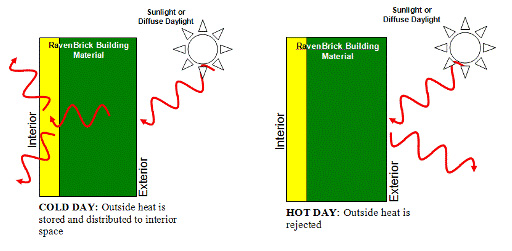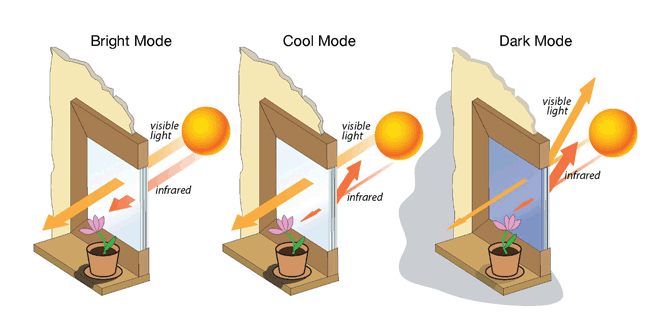The windows of a building are known to be the largest consumers of energy. Developers, builders, architects and home builders currently rely on reflective and energy efficient glass or low E-glass which makes use of a metallic coating to trap or reflect heat and light and thereby reduce energy costs. These types of windows have been popular for many years now but are limited in their usefulness as they are unable to react to temperature and light changes. This means that they block the solar energy when temperatures are cooler and have a tendency to trap warm air indoors when the weather is hot.
New technology has made significant improvements recently with the introduction of ‘smart glass’. Windows of the future, are in fact coming on in leaps and bounds. Electrochromic glass was one of the first types of smart glass to be used but they actually consume electricity which makes them less cost-effective in certain situations. Thermochromic windows are another new technology that’s becoming more available for modern buildings so we’ll take a look at how it works.
Thermochromic Windows
 As the name implies it is heat that makes this type of windows change their properties. A change in the ambient temperature will cause the glazing to change from clear to diffused. Gel based coatings are one technique that is used to achieve this revolutionary window as it uses a thin film of plastic that can be applied to almost any style of window assembly. The temperature response can be altered depending on the location and customer need. Another plus of this technology is that it can also turn white and be reflective. Which means that it can be used to reduce the transmission of solar heat. This will have an impact on the need for air conditioning when the weather is hot and sunny. However the fact that the glass loses its transparency makes it better suited for skylights rather than windows you want to look through.
As the name implies it is heat that makes this type of windows change their properties. A change in the ambient temperature will cause the glazing to change from clear to diffused. Gel based coatings are one technique that is used to achieve this revolutionary window as it uses a thin film of plastic that can be applied to almost any style of window assembly. The temperature response can be altered depending on the location and customer need. Another plus of this technology is that it can also turn white and be reflective. Which means that it can be used to reduce the transmission of solar heat. This will have an impact on the need for air conditioning when the weather is hot and sunny. However the fact that the glass loses its transparency makes it better suited for skylights rather than windows you want to look through.
Photochromic Windows
 One other option, although still in its development stage, is photochromic glass that respond to changes in light much like sunglasses that change when you move for bright to shady conditions. So far this technology has worked well on small pieces of glass but has yet to be done successfully on a much larger scale. The other drawback of this technology is that it works well in reducing the amount of glare from the sun but doesn’t have any effect on heat gain. For example the sun’s rays may strike the window more intensely in the winter because the sun is lower in the sky. Which would mean that the window would darken more in the winter than in the summer. Not very helpful when it’s in the winter that solar heat would be more beneficial.
One other option, although still in its development stage, is photochromic glass that respond to changes in light much like sunglasses that change when you move for bright to shady conditions. So far this technology has worked well on small pieces of glass but has yet to be done successfully on a much larger scale. The other drawback of this technology is that it works well in reducing the amount of glare from the sun but doesn’t have any effect on heat gain. For example the sun’s rays may strike the window more intensely in the winter because the sun is lower in the sky. Which would mean that the window would darken more in the winter than in the summer. Not very helpful when it’s in the winter that solar heat would be more beneficial.
We’re pretty sure that new technologies will continue to be explored when it comes to installing windows in buildings and it won’t be long before smart windows are affordable for everyone and any investment can be recouped quickly with their energy saving properties.
Yet there is another range of benefits that glass can offer. Except to be energy saving smart windows are being engineered to make our lives a lot easier and discover countless possibilities in our daily routines. It’s a vast topic really, so we leave you to enjoy a video by Corning Inc called “A Day Made of Glass”. It’s just for you to have a slight idea of what there could be in the near future and how our lives would completely depend on smart glass.
[youtube https://www.youtube.com/watch?v=6Cf7IL_eZ38]






